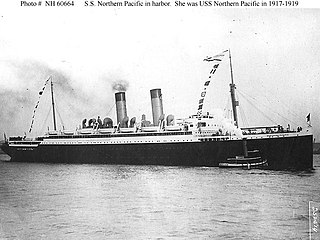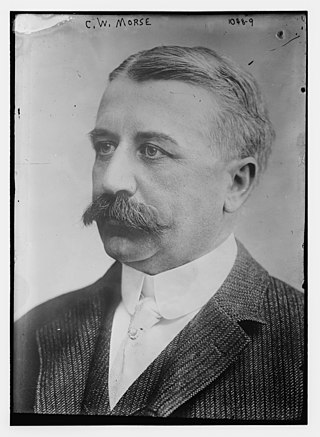
The United States Shipping Board (USSB) was established as an emergency agency by the 1916 Shipping Act, on September 7, 1916. The United States Shipping Board's task was to increase the number of US ships supporting the World War I efforts. The program ended on March 2, 1934.

SS Absaroka was a steamer, named after the Absaroka Range of mountains in Montana and Wyoming, completed in February 1918 for the United States Shipping Board (USSB) which briefly operated the ship. From 17 September 1918 to 4 March 1919 the ship was commissioned as USS Absaroka with the identification number IX-2581 in United States Navy and operated by the Naval Overseas Transportation Service.

The first USS Amphion was a former German passenger liner SS Köln for Norddeutscher Lloyd from 1899–1917. Köln had been interned in Boston on the outbreak of war in Europe and confiscated in April 1917 when the United States entered the war. The ship was under the control of the United States Shipping Board (USSB) that allocated commercial type ships to military or civilian use during the war. Köln was renamed Amphion and operated by USSB for the Army as United States Army Chartered Transport (U.S.A.C.T.) Amphion as an animal transport taking mules, horses and general cargo to forces in Europe. At the end of the war the USSB allocated the ship to the Navy, which used the ship from April to September 1919 as a troop transport for returning the United States Expeditionary Force from Europe.

SS Cotopaxi was an Emergency Fleet Corporation (EFC) Design 1060 bulk carrier built for the United States Shipping Board (USSB) under the World War I emergency shipbuilding program. The ship, launched 15 November 1918, was named after the Cotopaxi stratovolcano of Ecuador. The ship arrived in Boston, 22 December 1918, to begin operations for the USSB, through 23 December 1919, when Cotopaxi was delivered to the Clinchfield Navigation Company under terms of sale.

John Cornelius Butler was a Republican politician from New York. He was most notable for his service as a member of the United States House of Representatives from 1941 to 1949 and 1951 to 1953.

SS Northern Pacific was built as a passenger ship at Philadelphia by William Cramp & Sons under supervision of the Great Northern Pacific Steam Ship Company for the Spokane, Portland and Seattle Railway Company. Northern Pacific, along with sister ship Great Northern, were built to provide a passenger and freight link by sea between the Great Northern Railway Lines and Spokane, Portland and Seattle Railway terminal at Astoria, Oregon and San Francisco beginning in spring of 1915. The ship was acquired on 17 September 1917 for use as a transport ship for the United States Navy during World War I, commissioned USS Northern Pacific and later, after transfer to the United States Army, as the Army transport USAT Northern Pacific. She was destroyed by fire in 1922.

USS Majaba (AG-43/IX-102) was the Design 1049 cargo ship Meriden built in 1919 by the Albina Engine & Machine Works, Portland, Oregon. All the ships were requisitioned by the United States Shipping Board (USSB) for World War I service. The ship was bought by the E. K. Wood Lumber Co., of San Francisco, California in 1923 and renamed El Capitan. The ship was chartered by the U.S. Navy through the War Shipping Administration (WSA) in April 1942 and commissioned as Majaba.

USS West Apaum (ID-3221) was a cargo ship in the United States Navy during World War I. She had been built as SS West Apaum for the United States Shipping Board (USSB) as part of the West boats, a series of steel-hulled cargo ships built on the West Coast of the United States.

Charles Wyman Morse was an American businessman and speculator who committed frauds and engaged in corrupt business practices. At one time he controlled 13 banks. Known as the "Ice King" early in his career out of New York City, through Tammany Hall corruption he established a monopoly in New York's ice business, before buying several shipping companies and moving into high finance. His attempt to manipulate the price of copper-shares set off a wave of selling that developed into the Panic of 1907. Jailed for violating federal banking laws, he faked serious illness and was released. Later he was indicted for war profiteering and fraud.

USS West Ekonk (ID-3313) was a cargo ship for the United States Navy during World War I. She was later known as SS West Ekonk in civilian service under American registry, and as SS Empire Wildebeeste under British registry.

The Seattle Construction and Drydock Company was a shipbuilding company based in Seattle, Washington. Between 1911 and 1918, it produced a substantial number of ships for both commercial and military uses. In the beginning of the 20th century, until its significance was diluted by the emergence of a number of shipyards during the World War I shipbuilding boom, it was the largest of its kind in Seattle and one of the few significant ship yards along the West Coast of the United States, second only to the Union Iron Works in San Francisco.

William Mason Wright was a career officer in the United States Army. He attained the rank of lieutenant general and was most notable for his service as a division and corps commander during World War I.

SS President Taft was launched as one of the "state" ships, Buckeye State, completed by the United States Shipping Board as cargo passenger ships after originally being laid down as troop transports. Buckeye State had been laid down as Bertrice but was converted and renamed before launching. Originally assigned to the Matson Navigation Company as the Shipping Board's agent, the ship was later renamed President Taft and assigned to Pacific Mail Steamship Company for operation. In 1925 the Shipping Board sold the ship to Dollar Steamship Company. President Taft was operated by Dollar and then its successor American President Lines until requisitioned by the War Department on 17 June 1941.
Rock Island Bridge was a steam cargo ship built in 1919 by Submarine Boat Company of Newark for the United States Shipping Board (USSB) as part of the wartime shipbuilding program of the Emergency Fleet Corporation (EFC) to restore the nation's Merchant Marine. In March 1920 while on her maiden voyage the vessel collided with another steamer and subsequently had to be beached to avoid sinking. She was later abandoned and sold for scrap.
Kenwood Bridge was a steam cargo ship built in 1919 by Submarine Boat Company of Newark for the United States Shipping Board (USSB) as part of the wartime shipbuilding program of the Emergency Fleet Corporation (EFC) to restore the nation's Merchant Marine. In early 1920 the vessel was sold to Spanish company and renamed Leonita. In March 1921 while on passage to Italy with a cargo of coal she developed a leak and foundered.
SSCambridge was a Design 1023 cargo ship built for the United States Shipping Board immediately after World War I.
SSKehuku was a Design 1031 tanker ship built for the United States Shipping Board immediately after World War I.
The Design 1016 ship was a wood-hulled cargo ship design approved for production by the United States Shipping Board's Emergency Fleet Corporation (EFT) in World War I. As part of a larger effort to rapidly increase the country's shipping capacity, the EFT approved several standardized ship designs, including the Design 1016, which was intended to be easy to build and maintain, and to have a large cargo capacity.

The steamship Lake Farmingdale was steel-hulled freighter built for the United States Shipping Board in 1919. She spent most of her career in Southeast Asia as a passenger-cargo ship for the Pacific Mail Steamship Company, and, renamed Florence D., hauling timber for the Cadwallader-Gibson Lumber Company in the Philippines. She was sunk on 19 February 1942 by Japanese carrier aircraft while attempting to deliver arms and supplies to General Douglas MacArthur's forces in the Philippines.

The steamship Detroit Wayne was steel-hulled freighter built for the United States Shipping Board in 1919. She carried freight across the Atlantic in 1920 and 1921. Afterward, she was likely idled until 1932 when she was converted into a dredge for the U.S. Army Corps of Engineers. She was active in the Mississippi River for several years. In 1940, Detroit Wayne was sold to private interests, renamed Raritan, and converted back into a freighter. She was wrecked off the North Carolina coast in February 1942.



















